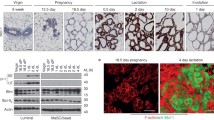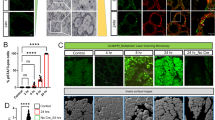Abstract
The mammary gland is a highly specialized organ that is able to repeat development and regression (involution) of alveolar structures for milk production. Mammary involution consists in two phases. The first phase is reversible and lasts until approximately 48 h after weaning in mice. Interestingly, an extended milking interval can change the milk-secretory activity of alveolar epithelial cells (AECs) before the first phase of involution begins. In this study, we investigate the changes in the ability of AECs to secrete milk during the involution progression. Careful observation of the number and locations of cleaved caspase-3 positive AECs revealed that the first phase of involution occurred approximately 24 h after weaning and the second phase began between 48 and 72 h after weaning. However, initial changes in the milk production ability of AECs began just 1 h after weaning and milk production gradually ceased within 24 h. In addition, activation of STAT3 and inactivation of STAT5 had occurred in some AECs by 6 h after weaning and more broadly by 24 h. In addition, milk production processes such as nutrient uptake, synthesis, and secretion ceased by 24 h post-weaning. Interestingly, enlarged cytoplasmic lipid droplets were observed in AECs 12 h after weaning even though the expression levels of genes relevant to triglyceride production (Srebp1 and AQP3) were down-regulated. These results indicate that several changes in the milk production ability of AECs occur during expanded suckling intervals and prior to involution.






Similar content being viewed by others
References
Anderson SM, Rudolph MC, McManaman JL, Neville MC (2007) Key stages in mammary gland development. Secretory activation in the mammary gland: it’s not just about milk protein synthesis! Breast Cancer Res 9:204
Ayadi M, Hammadi M, Khorchani T, Barmat A, Atigui M, Caja G (2009) Effects of milking interval and cisternal udder evaluation in Tunisian Maghrebi dairy dromedaries (Camelus dromedarius L.). J Dairy Sci 92:1452–1459
Ben Chedly H, Lacasse P, Marnet PG, Boutinaud M (2013) The decrease in milk yield during once daily milking is due to regulation of synthetic activity rather than apoptosis of mammary epithelial cells in goats. Animal 7:124–133
Blanchard AA, Watson PH, Shiu RP, Leygue E, Nistor A, Wong P, Myal Y (2006) Differential expression of claudin 1, 3, and 4 during normal mammary gland development in the mouse. DNA Cell Biol 25:79–86
Brew K, Vanaman TC, Hill RL (1968) The role of alpha-lactalbumin and the A protein in lactose synthetase: a unique mechanism for the control of a biological reaction. Proc Natl Acad Sci U S A 59:491–497
Brisken C (2002) Hormonal control of alveolar development and its implications for breast carcinogenesis. J Mammary Gland Biol Neoplasia 7:39–48
Brisken C, Socolovsky M, Lodish HF, Weinberg R (2002) The signaling domain of the erythropoietin receptor rescues prolactin receptor-mutant mammary epithelium. Proc Natl Acad Sci U S A 99:14241–14245
Camps M, Vilaro S, Testar X, Palacin M, Zorzano A (1994) High and polarized expression of GLUT1 glucose transporters in epithelial cells from mammary gland: acute down-regulation of GLUT1 carriers by weaning. Endocrinology 134:924–934
Chat S, Layani S, Mahaut C, Henry C, Chanat E, Truchet S (2011) Characterisation of the potential SNARE proteins relevant to milk product release by mouse mammary epithelial cells. Eur J Cell Biol 90:401–413
Clarkson RW, Heeley JL, Chapman R, Aillet F, Hay RT, Wyllie A, Watson CJ (2000) NF-kappaB inhibits apoptosis in murine mammary epithelia. J Biol Chem 275:12737–12742
Clarkson RW, Boland MP, Kritikou EA, Lee JM, Freeman TC, Tiffen PG, Watson CJ (2006) The genes induced by signal transducer and activators of transcription (STAT)3 and STAT5 in mammary epithelial cells define the roles of these STATs in mammary development. Mol Endocrinol 20:675–685
Connelly L, Barham W, Pigg R, Saint-Jean L, Sherrill T, Cheng DS, Chodosh LA, Blackwell TS, Yull FE (2010) Activation of nuclear factor kappa B in mammary epithelium promotes milk loss during mammary development and infection. J Cell Physiol 222:73–81
Han LQ, Li HJ, Wang YY, Zhu HS, Wang LF, Guo YJ, Lu WF, Wang YL, Yang GY (2010) mRNA abundance and expression of SLC27A, ACC, SCD, FADS, LPIN, INSIG, and PPARGC1 gene isoforms in mouse mammary glands during the lactation cycle. Genet Mol Res 9:1250–1257
Hughes K, Wickenden JA, Allen JE, Watson CJ (2012) Conditional deletion of Stat3 in mammary epithelium impairs the acute phase response and modulates immune cell numbers during post-lactational regression. J Pathol 227:106–117
Iavnilovitch E, Groner B, Barash I (2002) Overexpression and forced activation of stat5 in mammary gland of transgenic mice promotes cellular proliferation, enhances differentiation, and delays postlactational apoptosis. Mol Cancer Res 1:32–47
Kobayashi K, Oyama S, Numata A, Rahman MM, Kumura H (2013a) Lipopolysaccharide disrupts the milk-blood barrier by modulating claudins in mammary alveolar tight junctions. PLoS ONE 8:e62187
Kobayashi K, Oyama S, Uejyo T, Kuki C, Rahman MM, Kumura H (2013b) Underlying mechanisms involved in the decrease of milk secretion during Escherichia coli endotoxin induced mastitis in lactating mice. Vet Res 44:119
Kobayashi K, Uejyo T, Oyama S, Rahman MM, Kumura H (2013c) Histological analysis of mammary gland remodeling caused by lipopolysaccharide in lactating mice. Cell Tissue Res 354:495–506
Kreuzaler PA, Staniszewska AD, Li W, Omidvar N, Kedjouar B, Turkson J, Poli V, Flavell RA, Clarkson RW, Watson CJ (2011) Stat3 controls lysosomal-mediated cell death in vivo. Nat Cell Biol 13:303–309
Laspiur JP, Burton JL, Weber PS, Kirkwood RN, Trottier NL (2004) Short communication: amino acid transporters in porcine mammary gland during lactation. J Dairy Sci 87:3235–3237
Li M, Liu X, Robinson G, Bar-Peled U, Wagner KU, Young WS, Hennighausen L, Furth PA (1997) Mammary-derived signals activate programmed cell death during the first stage of mammary gland involution. Proc Natl Acad Sci U S A 94:3425–3430
Liu X, Robinson GW, Wagner KU, Garrett L, Wynshaw-Boris A, Hennighausen L (1997) Stat5a is mandatory for adult mammary gland development and lactogenesis. Genes Dev 11:179–186
Lund LR, Romer J, Thomasset N, Solberg H, Pyke C, Bissell MJ, Dano K, Werb Z (1996) Two distinct phases of apoptosis in mammary gland involution: proteinase-independent and -dependent pathways. Development 122:181–193
Markov AG, Ruhle HJ (1992) The influence of exogenous oxytoxin on labelling of secretory epithelium of mouse mammary gland by [3H]leucine, evidenced by autoradiography. Exp Clin Endocrinol 100:112–116
Matsuzaki T, Machida N, Tajika Y, Ablimit A, Suzuki T, Aoki T, Hagiwara H, Takata K (2005) Expression and immunolocalization of water-channel aquaporins in the rat and mouse mammary gland. Histochem Cell Biol 123:501–512
Monks J, Smith-Steinhart C, Kruk ER, Fadok VA, Henson PM (2008) Epithelial cells remove apoptotic epithelial cells during post-lactation involution of the mouse mammary gland. Biol Reprod 78:586–594
Nakatani H, Aoki N, Nakagawa Y, Jin-No S, Aoyama K, Oshima K, Ohira S, Sato C, Nadano D, Matsuda T (2006) Weaning-induced expression of a milk-fat globule protein, MFG-E8, in mouse mammary glands, as demonstrated by the analyses of its mRNA, protein and phosphatidylserine-binding activity. Biochem J 395:21–30
Nakatani H, Yasueda T, Oshima K, Okajima T, Nadano D, Flint DJ, Matsuda T (2013) Post-weaning increases in the milk-fat globule EGF-factor VIII on fat globules in mouse milk and in the uptake of the fat globules by HC11 mammary epithelial cells. J Biochem 153:31–41
Neville MC, Morton J, Umemura S (2001) Lactogenesis. The transition from pregnancy to lactation. Pediatr Clin N Am 48:35–52
Nudda A, Bencini R, Mijatovic S, Pulina G (2002) The yield and composition of milk in Sarda, Awassi, and Merino sheep milked unilaterally at different frequencies. J Dairy Sci 85:2879–2884
Pitelka DR, Hamamoto ST, Duafala JG, Nemanic MK (1973) Cell contacts in the mouse mammary gland. I. Normal gland in postnatal development and the secretory cycle. J Cell Biol 56:797–818
Quaglino A, Salierno M, Pellegrotti J, Rubinstein N, Kordon EC (2009) Mechanical strain induces involution-associated events in mammary epithelial cells. BMC Cell Biol 10:55
Rudolph MC, McManaman JL, Hunter L, Phang T, Neville MC (2003) Functional development of the mammary gland: use of expression profiling and trajectory clustering to reveal changes in gene expression during pregnancy, lactation, and involution. J Mammary Gland Biol Neoplasia 8:287–307
Rudolph MC, Neville MC, Anderson SM (2007) Lipid synthesis in lactation: diet and the fatty acid switch. J Mammary Gland Biol Neoplasia 12:269–281
Rudolph MC, Monks J, Burns V, Phistry M, Marians R, Foote MR, Bauman DE, Anderson SM, Neville MC (2010) Sterol regulatory element binding protein and dietary lipid regulation of fatty acid synthesis in the mammary epithelium. Am J Physiol Endocrinol Metab 299:E918–E927
Schwertfeger KL, McManaman JL, Palmer CA, Neville MC, Anderson SM (2003) Expression of constitutively activated Akt in the mammary gland leads to excess lipid synthesis during pregnancy and lactation. J Lipid Res 44:1100–1112
Scribner KC, Wellberg EA, Metz RP, Porter WW (2011) Singleminded-2s (Sim2s) promotes delayed involution of the mouse mammary gland through suppression of Stat3 and NFkappaB. Mol Endocrinol 25:635–644
Stelwagen K, Farr VC, McFadden HA, Prosser CG, Davis SR (1997) Time course of milk accumulation-induced opening of mammary tight junctions, and blood clearance of milk components. Am J Physiol 273:R379–R386
Strange R, Li F, Saurer S, Burkhardt A, Friis RR (1992) Apoptotic cell death and tissue remodelling during mouse mammary gland involution. Development 115:49–58
Teglund S, McKay C, Schuetz E, van Deursen JM, Stravopodis D, Wang D, Brown M, Bodner S, Grosveld G, Ihle JN (1998) Stat5a and Stat5b proteins have essential and nonessential, or redundant, roles in cytokine responses. Cell 93:841–850
Tolkunov YA, Markov AG (1997) Integrity of the secretory epithelium of the lactating mouse mammary gland during extended periods after suckling. J Dairy Res 64:39–45
Watson CJ (2006) Involution: apoptosis and tissue remodelling that convert the mammary gland from milk factory to a quiescent organ. Breast Cancer Res 8:203
Watson CJ, Kreuzaler PA (2011) Remodeling mechanisms of the mammary gland during involution. Int J Dev Biol 55:757–762
Acknowledgment
This work was supported by a Grant-in-Aid for Young Scientists (24780281) from the Japan Society for the Promotion of Science.
Author information
Authors and Affiliations
Corresponding author
Rights and permissions
About this article
Cite this article
Uejyo, T., Kuki, C., Oyama, S. et al. Early down-regulation of milk production after weaning by pup removal and prior to involution in mouse mammary glands. Cell Tissue Res 359, 643–653 (2015). https://doi.org/10.1007/s00441-014-2013-7
Received:
Accepted:
Published:
Issue Date:
DOI: https://doi.org/10.1007/s00441-014-2013-7




